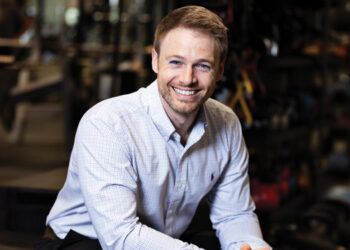How Club Fit’s “small church mentality” helped it navigate the pandemic, and why the local community remembers its acts of kindness.
The nature of crises is they are impossible to predict. You never know when disaster will strike or from what angle.
A global pandemic is a great example. But so are natural disasters such as storms and flooding, including that resulting from Hurricane Ida in August 2021. The Category 4 storm caused severe damage and wreckage from Louisiana to New York to Connecticut, with 43 fatalities in the Northeast alone and 82 total.
A few days after the worst of Hurricane Ida had subsided, Club Fit general manager Lynne Welling was in her office, which sits just outside the front desk at the Jefferson Valley, New York, location. She overheard a community member asking the front desk attendant if they could use the gym’s facilities because they had no power, stating they remembered Club Fit doing so in the past. They were of course told yes.
“We’ve always been responsive to circumstances in our community, and that’s something our community remembers,” said Welling. “That wasn’t a gym member coming in, but a member of the community. Because our community isn’t just within our walls. It really extends out, and those ties are what set us apart.”

Although Club Fit’s two locations in New York are massive — each boasting around 100,000 square feet — the co-owner Bill Beck said they strive to foster a “small church mentality” within the organization.
In addition to supporting the community during natural disasters such as hurricanes, this “small church mentality” involves fundraising for local charities and donating space to community partners. It can also be seen in the team’s effort to know as many faces and names as possible, and notice when people aren’t there.
To achieve this goal, Club Fit takes great pains to truly integrate and onboard members into the facility, with offerings ranging from tennis, racquetball and pickleball to group fitness, basketball and complimentary small group training. The more a member uses the club — especially through offerings that involve others — the more likely they are to stay.
“It’s that ‘small church mentality,’ right?” said Beck. “In certain big churches, if you don’t go to service nobody really notices. With small churches, if you miss service somebody calls you and says, ‘Where were you today?’ And we find that with exercise. When we can create these pods of people in groups, they definitely come to and enjoy the club more, see better results and stay longer. It is a virtuous circle.”
According to Beck, it’s more important than ever for clubs to think about exercise adherence — essentially, what motivates someone to not only join a gym but actually use it and stay a long-time member? For Club Fit, its programming and small group formats provide that answer.
However, exercise adherence also involves offerings and services that cater to people wherever they are on their fitness journey. Is a member recovering from surgery or looking to improve their tennis game? How about seeking to increase mobility or foster positive mental health through socialization? Club Fit is there to meet each of those needs.
Put another way, variety is the spice of life. And that’s also the case for a successful, long-sustaining exercise routine over the course of a lifetime.
“As you think about exercise adherence over decades rather than weeks, you find most people need some amount of variety,” said Beck. “Too long doing the exact same thing leads to drop out and failure. Our members move from class to class, from tennis to pickleball, from the fitness center to yoga. When we watch our long-term members, we see that over long periods of time they typically use many areas of the club. This variety is in fact the thing that has kept them members for so long.”

Beck acknowledged for many Americans, exercise just isn’t fun or at the top of their priority list. As a result, gyms must get creative to foster exercise adherence.
This is especially true for the deconditioned or non-exerciser. Historically, gyms have had an extremely difficult time not only attracting but keeping this population as customers.
For Beck, overcoming this challenge involves utilizing empathy — understanding someone’s worldview that may have led them to be exercise resistant. He shared an experience he had in undergrad that was pivotal to developing this understanding, where he and his classmates were asked to carry their current weight around in a backpack. For example, if you weighed 150 pounds, you had to carry an extra 150 pounds around for the next hour.
Beck said the exercise was an eye-opener regarding what it feels like to be obese, and how challenging it would be to suddenly pick-up an exercise routine at that starting point.
According to Beck, he has since realized the mindset in fitness of “no pain, no gain” is inherently flawed. Instead, it’s important to simply encourage people to participate in movement and physical activity.
“This whole idea of ‘no pain, no gain’ is really quite silly,” said Beck. “Most people don’t want to be in pain, they just want to move. They do want to lose some weight, they do want to feel better. And pain is hardly the recipe for helping people continue an exercise program. If you can find ways to just dip their toe into the water and get them moving, and not feel terrible the next day, they’ll want to come back. We spend time with our new staff trying to bring them through that dynamic. Athletes believe in ‘no pain, no gain.’ Nobody else does.”
According to Ellen Koelsch, a co-owner of Club Fit and Beck’s sister, this philosophy is also prevalent in Club Fit’s marketing strategy, with the club emphasizing messaging surrounding relatable member success stories versus those on the extreme end of the spectrum.
“Sometimes we do have great stories where someone’s accomplished something as astonishing as climbing Mount Everest,” said Koelsch. “We make the stories more about how someone has navigated their life through fitness, and how they feel better. These are also remarkable accomplishments — to get through life and be a little healthier at the end of the day.”
Essentially, Club Fit’s strategy seeks to inspire the community to fitness through the real-life stories of their neighbors, friends and family.

“We’re trying to recreate what might happen at a dinner party pre-pandemic — where people naturally share stories of ‘I did this,’ or ‘my neighbor did that,’” shared Koelsch. “The goal is to inspire people to realize Club Fit might meet their or a friend’s needs through marketing.”
And once someone is referred to Club Fit and makes that transition from prospect to member, they’re not just joining a gym but a supportive community that truly cares about each individual’s success.
While this is showcased in Club Fit’s attention to member onboarding and inclusivity, it’s also in the way it ensures a healthy and safe environment.
According to Ted Gilsinger, the general manager of Club Fit’s Briarcliff location, even prior to COVID-19 the team was on high-alert regarding cleaning, sanitizing and air quality, with the goal of utilizing products both effective and safe from a health perspective.
“I had been really on a kick of changing our club to not only a healthy club, but a healthy environment and a healthy floor, both internally and out,” said Gilsinger. “If we can move to cleaner energy and support the environment, we’re supporting our community.”
Prior to the pandemic, Club Fit had transitioned to fully biodegradable wares for its café, started a solar energy project, improved air circulation through an investment in Big Ass Fans, and began using Viking Pure Solutions as a natural cleaning and disinfecting solution.
Post-pandemic, they made even more investments, including incorporating AIRPHX into the HVAC system, which purifies the air by killing bacteria, viruses and pathogens in the air and on surfaces. They also added HEPA and MERV 13 filtration systems in smaller environments like studios or office spaces, and iWave-C air ionization systems in larger spaces like the indoor tennis bubble.

According to Gilsinger, these investments pre- and post-pandemic have paid off, as indicators that Club Fit truly cares about the people who work, and workout, within its four walls.
“When members came back from the shutdown, many said, ‘Thank God you have this or that, because I feel safer,’” said Gilsinger. “And some people remembered our earlier investments, which gave them even more confidence. They already knew we were invested in the health of the environment. All the things we were doing before built trust that what we implemented was going to work.”
As Welling said at the beginning of this story: “The community remembers.”
As a result, the ultimate takeaway from Club Fit’s success is that in times of crisis, you reap what you sow. If you had a great culture and community prior to a disaster, it’s likely you’ll make it through.
“It would be hard to recover from not having a good culture in the middle of a crisis,” said Koelsch. “I feel very grateful we were able to lean on the trust we had built up over the years to navigate this time.”
Stay ahead in the fitness industry with exclusive updates!
Rachel Zabonick-Chonko is the editor-in-chief of Club Solutions Magazine. She can be reached at rachel@peakemedia.com.











